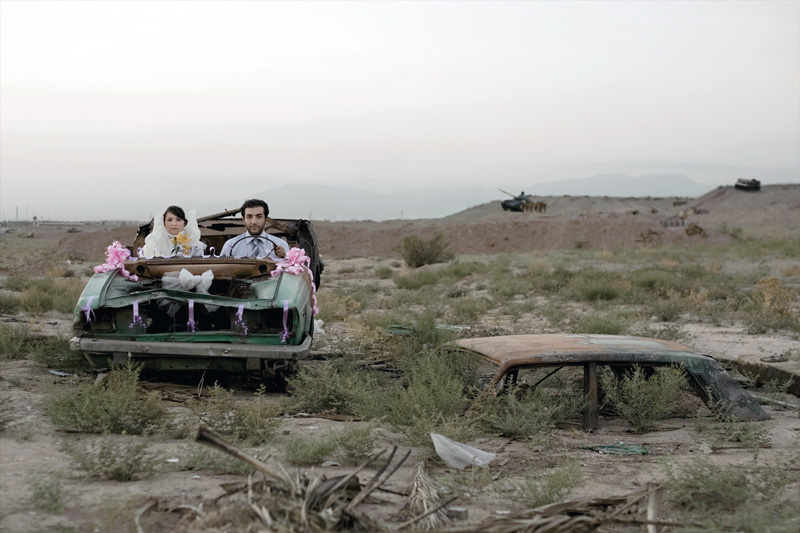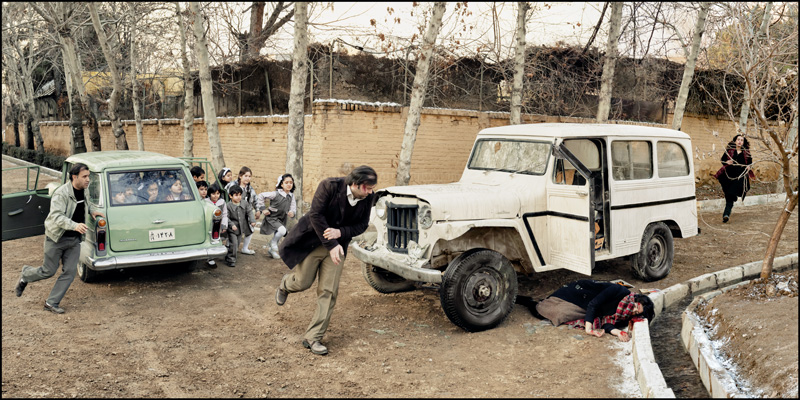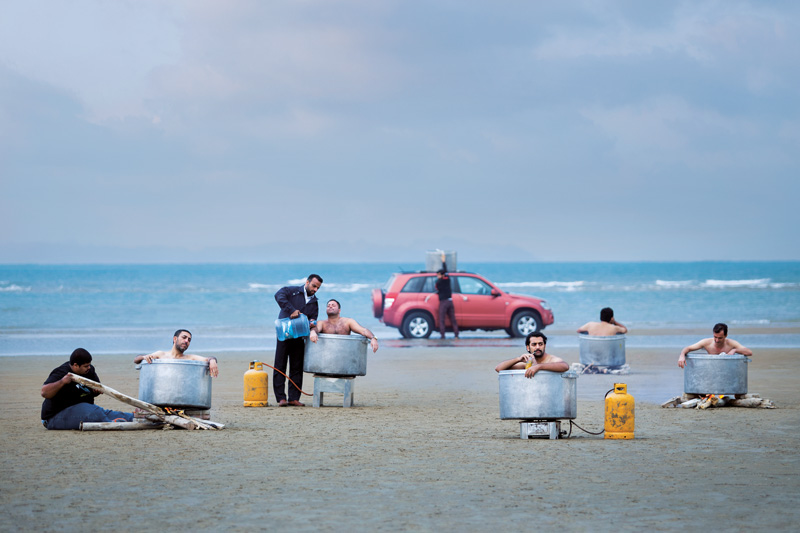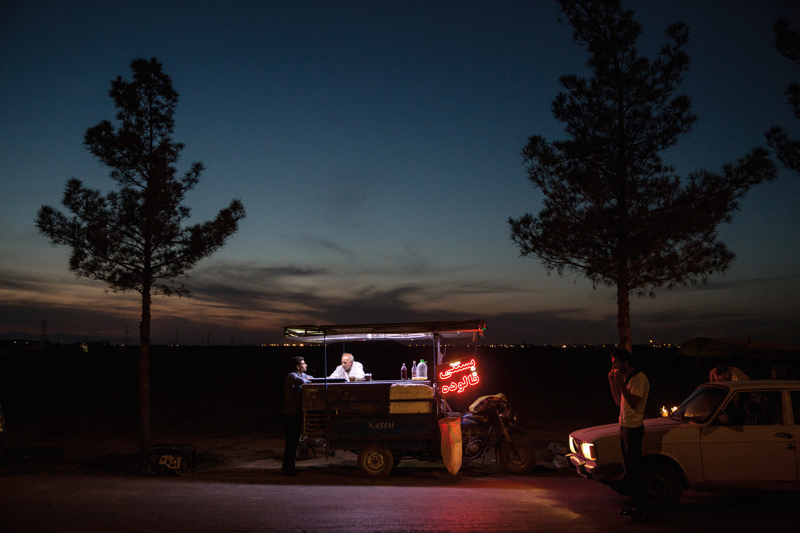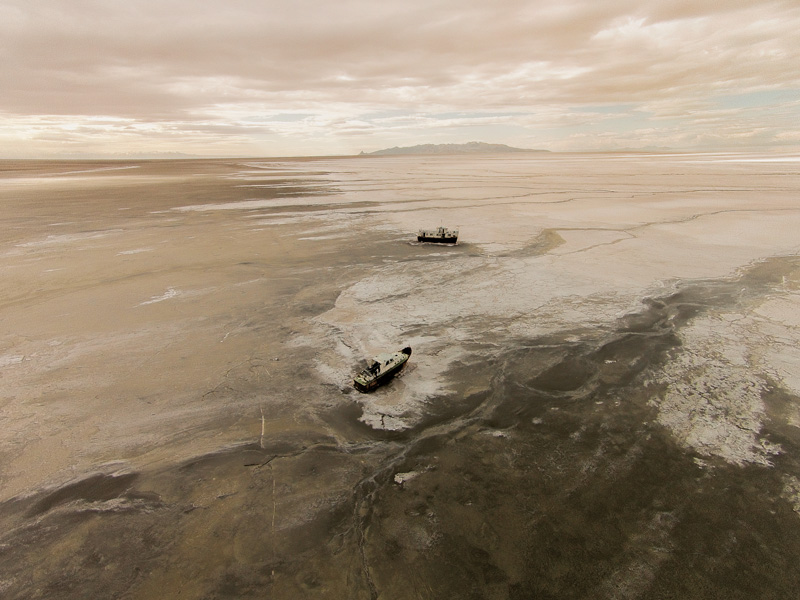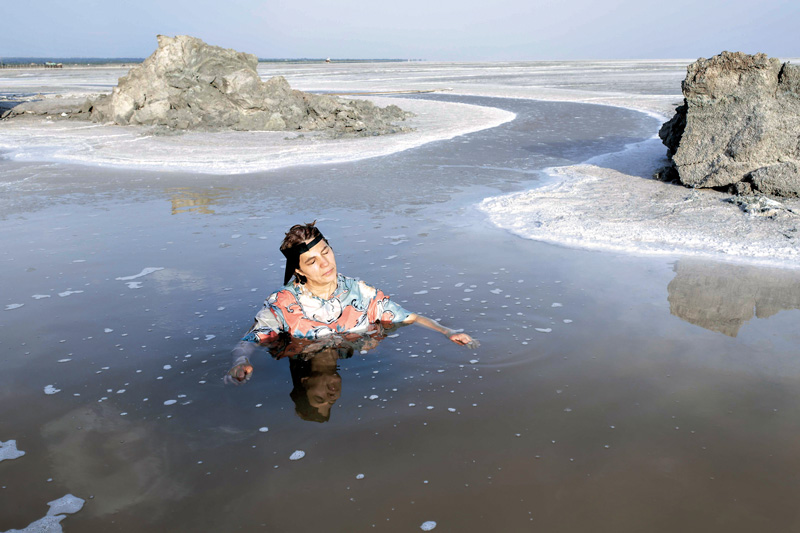By Claudia Polledri
Written in Farsi on a white box abandoned on the black asphalt of Pahlavi Avenue in Tehran, the day after the Islamic revolution prevailed – on February 11, 1979 – is “The nation is victorious.” This is the first image in the exhibition Iran, Année 38,1 presented at the most recent edition of the Rencontres d’Arles. Thirty-eight years in images, sixty-six photographers, and, as a backdrop, an emergent country, with its conflicts, contradictions, traditions, and all the poetry of its imagination. Of course, it is not by chance that the curators, Anahita Ghabaian Etehadieh (director of the Silk Road Gallery, Tehran) and Newsha Tavakolian (Magnum Photos), chose to open the exhibition on a documentary note. It is a way of presenting one of the major events in twentieth-century Iranian history, and a way of linking contemporary Iranian photography to a specific historical period. And yet, all we have to do is lift our eyes from this image to glimpse, in the distance, a completely different image at the back of Sainte-Anne church, which is hosting the exhibition. This picture, taken during shooting of the movie Taste of Cherry (1997), shows the celebrated Iranian director Abbas Kiarostami from the back as he peeks through a curiously “closed” gate at an empty landscape.
The exhibition, in which “poetic” never means “distanced from history,” takes place in the gap between these two images. The resulting rich dialogue between documentary and art photography is organized into eight sections. Presented here are not only the major historical upheavals of contemporary Iran – the Islamic revolution (1979) and the Iran–Iraq war (1980–88), along with their political and religious outcomes – but also a country of majestic landscapes threatened by environmental crisis, and, above all, a portrait of Iranian society’s most intimate recesses, tragedies, expectations, and multiple contradictions. In terms of the contradictions, it is the tension between tradition and modernity that provides the most photographically poetic images, in which identity is sought through the Persian poetic tradition and the ancient heritage of the Persian empire. It is in this vein that the exhibition closes with references to Kiarostami and Iranian filmmaking, crucible of traditions and new narratives, the visual quotation of which reaffirms the influence of the poetic over the real.
A successful follow-up to Etehadieh’s first book, La photographie iranienne. Un regard sur la création contemporaine (2011), Iran, Année 38 includes photojournalism pictures that speak to both the exhibition’s panoramic scope and the desire to survey the country’s history through photography, including, for the first time, images taken during the Iranian revolution. Photographs by Kaveh Kazemi, Bahman Jalali, Maryam Zandi, and Rana Javadi reveal all the ferment and commitment of Iranian young people during demonstrations, as well as the strong repression exerted during the months preceding the birth of the Islamic Republic proclaimed by Ayatollah Rouhollah Khomeini. It is this difficult relationship between the regime and images that a shot taken by Kazemi (on February 12, 1979) portrays: we see the hand of an armed woman in a chador, a member of the revolutionary forces, held up against the camera. It is a visual translation of the increasingly frequent bans on recording or distributing images.
It was in part in reaction to the desire to control images, which resurged in 2009 during the “green revolution” against the presidency of Mahmoud Ahmadinejad (2005–13), that art photography began to develop, a sign of the need to create spaces for expression and “staging reality,” in a context in which the production of images remained heavily supervised. According to Newsha Tavakolian, being an artist in Iran is like walking in a minefield, as artists have to comply with a series of constraints in order for their images to circulate in public and be exhibited in the many Tehran galleries. Many codes structured the conception and production of photographic images, including the choice of subjects, and artists are constantly trying to find ways around them. For example, representation of the human body is still taboo and for women the veil remains a constant, both in life and in pictures.
This has not kept photographers from offering their interpretation of the country, often by casting a critical gaze at it and unveiling its most private features. To do this, real and symbolic reference to the space of the home is very present not only during the making of images, but also as a medium for inscribing in the present the visual remains of past events. This is the case for Babak Kazemi’s series Khorramshahr numéro après numéro (2008), in which dramatic images from the Iran–Iraq war are transferred onto address-number plates on houses in Khorramshahr, a border town particularly affected by the conflict; in Saba Alizadeh’s series La lumière et la Terre (2011), the war “re-enters” the home in the form of documentary images projected on a sofa in the living room. The result is emotional – silent symptoms of the mourning that still haunts Iranian families. Still linked to the space of the home, Shadi Ghadirian’s Nil Nil series features juxtapositions, both simple and upsetting, of daily objects (high heels, a plate, a bed and its bedclothes) against objects of war (weapons, bloody boots); here, Ghadirian makes room for women’s view of the conflict.
Photographing domestic space is not only about “making room” for family memories, for the absence of those who have left the country, or for depicting a refuge where all forms of outside control can be evaded. For Newsha Tavakolian, the interior of an apartment becomes a set for staging Iranian society during the era of “torpor” that occurred under Ahmadinejad’s presidency – a particularly difficult phase for the middle class because of the hardening of international sanctions that resulted from the republic’s nuclear ambitions. In her series Regard (2012–13), displayed in the exhibition in the form of video installation, we see precisely this “torpor” on numbed, deadened faces, the features immobilized by suffering in a country that is also immobilized, and the setting that they share – a series of towers on the periphery of Tehran – creates an even greater sense of constriction.
Also evident in the photographers’ preoccupations the public space of the city, often seen as inhospitable. A sense of discomfort is transmitted by Mehran Mohajer in Téhéran, an image of deserted streets of the capital captured with a pinhole camera; by Hoda Amin’s high-angle shot of two black figures, a man followed by a woman, walking down an empty street, titled Toundra (2013); and by the faces in Bahram Shabani’s series Portraits du soir (2014), dark images in which we see in the eyes of the people portrayed a sense of anxiety and suspicion that the photographer accentuates with an almost-theatrical use of light. A feeling of the surreal pervades the series Espace public, by Morteza Niknahad and Behnam Zakeri (2015), in which an almost-ironic contrast plays out between the men taking warm baths on the beach and the waves in the background.
Today, given a political and religious framework that is still restrictive and, as one section in the exhibition shows, determines what Iranians “should be,” the question of identity emerges strongly and also infiltrates the visual field. As we can observe in Ghazaleh Hedayat’s Judas (2006), which shows a blown-up detail of an Iranian passport, photography bears witness to this questioning and gives shape to identity-related tensions in Iranian society, which is dealing with an ancient heritage and an aspiration to modernity. The poetry that surrounds these images comes from the mobilization of traditional decorative objects or motifs placed in new contexts by the photographers to give them fresh meaning. This is the case for Jalal Sepehr’s Zone rouge (2015), in which the carpets laid out in the desert describe the “red zone” that is the Middle East, which, according to Sepehr, “begins where roads stop, where time, space, and norms are shattered.” In Babak Kazemi’s photograph, the carpet enwraps but also separates the floating bodies of a couple in a portrayal of the ancient Persian legend of Shirin and Farhad and their star-crossed encounter, which becomes a metaphor for the difficulties that couples today have with expressing their relationship freely. A Persian legend is also portrayed in the veil that covers the face of the young woman photographed by Sadegh Tirafkan, although the decorative veil seems to rob her of any possibility of speaking. On the other hand, Shadi Ghadirian’s series Qâjar (1998) reveals that as a sign of protest women of this era (1779–1925) raised their veils to show at least their faces. Ghadirian has chosen to take up this theme: she uses the same sepia tones of images of the time, and the women take the same poses and gestures, but a symbolic object is added to reconnect them to the present day: radio, bicycle, vacuum cleaner, newspaper, musical instrument – modern objects, linked through the photographic image to an ancient form of protest.
In the end, it is perhaps these tensions and the complex questions that they raise that form the essence of contemporary Iranian photography. This portrait of society refers us to Kiarostami’s famous movie Shirin, reprised in Gelareh Kiazand’s photograph 100 Portraits (2007), in which the camera is trained on the faces of 108 women watching a screening of the famous traditional Persian tragedy. This exhibition has similarly captured the face of the country by showing us its tragedies and how beauty and poetry survive there.
Translated by Käthe Roth
A postdoctoral student and lecturer in the department of art history and cinematographic studies at the Université de Montréal, Claudia Polledri is also the university’s academic coordinator of the Centre de recherches intermédiales sur les arts, les lettres et les techniques. She holds a doctorate in comparative literature from the Université de Montréal; her dissertation subject was photographic representations of Beirut (1982–2011). Currently she is conducting research on the relationship between image and history in Lebanese documentary cinema.


